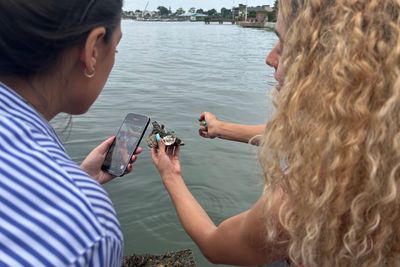"This story was originally published by Grist. Sign up for Grist's weekly newsletter here."
The Mississippi River is a connected system. If farms dump fertilizer into the river’s tributaries in Ohio, that waste ends up in the Gulf of Mexico. If heavy rains make the river’s level rise in Illinois, it puts pressure on flood levees in Arkansas.
And if a hot, dry summer sweeps across the Midwest, drying the river out for hundreds of miles downstream, something very strange happens in southern Louisiana.
For the past month, as the water level on the lower Mississippi River sinks lower amid an extreme drought stretching from Nebraska to Ohio, a mass of salt water has been pushing upriver from the Gulf of Mexico toward New Orleans, filling the space where fresh water should be. Salt water is heavier than fresh water, so the water forms the shape of a wedge pressing against the bottom of the river. The wedge has already slithered more than 50 miles upstream, passing several small communities in rural Plaquemines Parish, and experts say it will likely reach New Orleans by the end of the month. Even as local and federal officials rush to slow down the wedge, they’re finding themselves powerless against the laws of nature.
The wedge poses a serious threat to the drinking water supply in communities along the river. Salt water has already begun to contaminate local water systems in the towns of Port Sulphur and Pointe à la Hache, and by the end of next week it will likely reach suburban Belle Chasse, home to around 10,000 people. Rural communities in lower Plaquemines Parish have been drinking bottled water and showering in salty tap water for multiple weeks, and it was only this week that officials installed reverse-osmosis filters at the parish’s treatment plant to remove salt from the local water supply.
When humans drink salty water, the elevated sodium in their blood can raise their blood pressure and make their kidneys work harder. This can be harmful for children and pregnant women, as well as those who need to maintain low-sodium diets for medical reasons.
“There is not a firm black line when it becomes unhealthy,” said Joseph Kanter, the state health officer for Louisiana, in a recent interview with the New Orleans Times-Picayune. For sensitive groups, he added, “it wouldn’t be bad advice to switch over to bottled water” when the salinity of local water supplies exceeds 250 parts per million, about the threshold at which water starts to taste salty.
The wedge could cause even more significant health problems as it reaches New Orleans. The city has some 50,000 drinking-water pipes that are made out of lead, and the corrosive salt water would permanently damage those pipes as it moved through the system, allowing lead and other chemicals to leach into water. Research shows that drinking water contaminated with heavy metals can significantly increase one’s risk of brain damage, liver damage, kidney damage, and cancer. Exposure is most dangerous for young children.
Louisiana has dealt with several of these so-called wedges before during drought years. The last time a wedge threatened the city of New Orleans was in 1988, when salt water came within a few miles of the freshwater intake valve in the city’s Carrollton neighborhood, the largest source of drinking water for the city. Residents rushed to stock up on bottled water, buying so much of it that a local bottler ran out of stock. State leaders tried to stop the panic, with one health official telling the media that the water contained “less salt than a box of Popeyes Fried Chicken.”
The federal government has already begun sending resources to Louisiana, but its options are limited. The Federal Emergency Management Agency, which resumed funding all disaster projects this week thanks to a last-minute infusion of money from Congress, has agreed to help four river parishes manage the costs of responding to the disaster. Local officials will be able to seek reimbursement from FEMA in the coming months for money they spend on bottled water or treatment infrastructure.
The Army Corps of Engineers, the federal civil works agency that manages the river, is working to dilute the salt contamination in local water supplies by hauling in fresh water on barges. The agency delivered its first barge of water to Plaquemines Parish on Monday, dropping off 500,000 gallons at the Port Sulphur treatment facility, where officials have been dealing with contamination for weeks. The agency says it will soon be able to deliver 36 million gallons of water a day to the region, which is more than enough to dilute water for towns downstream of New Orleans.
But the imported water won’t be enough to stop contamination at the much larger water intake facilities in New Orleans. Instead, local officials with the city’s Sewerage and Water Board are hoping FEMA will reimburse them for the cost of building a 12-mile pipeline that would pump water to the city from further upstream, near the city of Kenner. Sewerage and Water Board officials have said the pipeline could cost more than $150 million and begin operations by the end of the month. A spokesperson for the agency told Grist that the agency is in the process of reviewing bids from construction firms and that it expects FEMA to cover the cost of construction. In the meantime, neighboring Jefferson Parish has already begun preliminary construction on its own pipeline.
As far as stopping the wedge itself, that’s almost impossible to do. The Corps has constructed a “sill,” or underwater levee, to stop the progress of the water. The barrier should slow down the saltwater intrusion for a few weeks, but there’s no way to prevent the water from moving upstream without damming the river altogether, which is impossible.
It will take a heavy round of rainfall in the Upper Midwest to put a permanent end to the crisis, and that might not arrive for months. The Mississippi’s current flow is about 150,000 cubic feet per second, about half of what officials say is necessary to push the salt water back out into the Gulf. Forecasts in the Mississippi and Ohio River watersheds call for around an inch of rain over the coming week, but it could take as much as 10 inches to restore the river’s normal flow.
It was this inescapable truth that informed Kanter’s other main piece of advice.
“Pray for rain in the Ohio Valley,” the state health official told the Times-Picayune.




